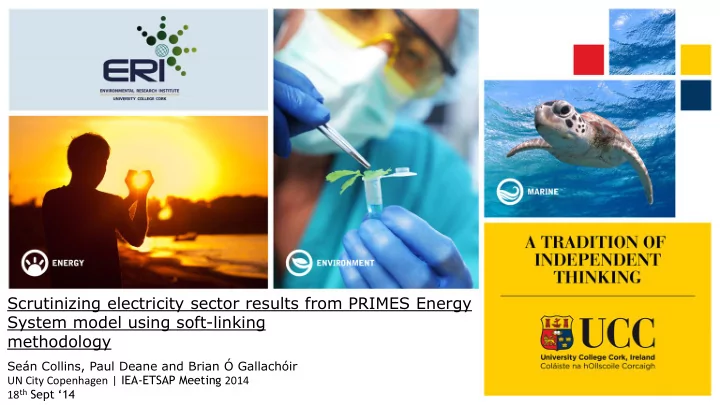

Scrutinizing electricity sector results from PRIMES Energy System model using soft-linking methodology Seán Collins, Paul Deane and Brian Ó Gallachóir UN City Copenhagen | IEA-ETSAP Meeting 2014 18 th Sept ‘14
Overview • Objectives • Methodology • Software used • Multi-Model Approach • Data Utilised • Model Structure • Scrutinization of Results
Objectives • To test the technical appropriateness and robustness of PRIMES Reference Scenario results for the electricity sector. • Identify concerns which accompany them, including : Generation Adequacy and reliability of the power system Renewable curtailment Flexibility of the power system to absorb variable renewables Congestion on interconnector lines
Methodology • A soft-linking methodology was employed to scrutinize specific results from the electricity sector for a target year. + Deane, J.P., Chiodi, A., Gargiulo, M., Ó Gallachóir, B.P., 2012. Soft-linking of a power systems model to an energy systems model. Energy 42, 303 – 312. doi:10.1016/j.energy.2012.03.052 • Done using a dedicated power system model (PLEXOS). • Model simulates the operation of the EU power system at high temporal and technical resolution for a target year.
The Software we use for electricity/gas: PLEXOS • Academic License Main slide text • Transparent and auditable • Strong commercial user base • Strong R&D focus from development team • Production Cost Simulation • Electric and Gas modelling • Capacity Expansion Capability • Market Analysis and Market Design • Transmission Analysis • Stochastic Optimisation • Hydro Generation Resource Management
Multi-Model Approach - EU PLEXOS Integrated Gas and Electricity model soft-links to PRIMES Energy system model or TIMES Integrated Energy System Model Power System Model Provides: -Detailed analysis of energy system model results using soft-linking techniques + -High temporal resolution (15min-1 hr) -High technical detail, reserve modelling, hydro modelling, multi-stage stochastic UC -Ramping costs, flexibility metrics EU 28 Model- 3,000 generators, 22 PHES Units, 53 IC Lines + Deane, J.P., Chiodi, A., Gargiulo, M., Ó Gallachóir, B.P., 2012. Soft-linking of a power systems model to an energy systems model. Energy 42, 303 – 312. doi:10.1016/j.energy.2012.03.052
Process PRIMES Installed Capacities Reference Generation Mix Scenario 2030 Constraints Local Hourly Wind and PRIMES 2030 EU-28 Solar Generation PLEXOS Model Profiles Electrical Power Demand Profiles & Interconnection levels
Data Utilised PRIMES Results • The PRIMES model is a modelling system that simulates a market equilibrium solution for energy supply and demand. The model is organized in sub-models (modules), each one representing the behaviour of a specific (or representative) agent, a demander and/or a supplier of energy. • These include predicted installed generation capacities, Gross & Net Electrical Generation by plant type and indicators for electricity generation among other results
Data Utilised Wind Generation Data (Hourly) • Based on NASA MERRA Data • Developed Wind Profiles in countries in line with capacity factors outlined in PRIMES • Wind profiles based on local condition in all countries • Created Normalised generation profiles in line with PRIMES generation capacities • Based on multi turbine generation curve Solar Generation Data (Hourly) • Calculated using PV Watts online package developed by NREL • Solar profiles based on local solar irradiation data for all countries • Normalised Profiles created for PLEXOS model
Data Utilised Electrical Demand Data (Hourly) • Sourced for individual countries from ENTSO-E Levels of interconnection • The level of interconnection between member states are considered. • Present Day figures interconnection data sourced from ENTSO-E • 2030 Interconnection levels determined from ENTSO-E Ten Year Network Development Program
Structure of Model in Excel Automatically adjusts to changes in PRIMES 2030 Capacity & Generation figures Reference data sheet for power plant data (heat rate, start up cost maintenance rate, fuel price etc.) common for all EU-28 Workbooks can be easily created/edited and linked to external data sources Transparent method for large model building for Non- PLEXOS users
Results - Loss of Load Probability LOLP 0.4 0.35 0.3 0.25 0.2 0.15 0.1 0.05 0
2030-Hours of Congestion on IC Lines NTC between MS
2030 Curtailment (%) Ref Scenario NTC between MS NTC between MS
Total Generation Costs NTC between MS NTC between MS
2030 – Prices
Conclusions • Soft Linking methodology provides a firm test of the appropriateness of PRIMES 2030 Results • Preliminary results from this model indicate: – Potential overestimation of flexibility of wind generation in PRIMES Ref Scenario – The need for increased interconnection between member states Future work: – Incorporate CHP in model, Include Switzerland and Norway in model and improve renewable energy profiles
Thank You www.ucc.ie/energypolicy
Recommend
More recommend